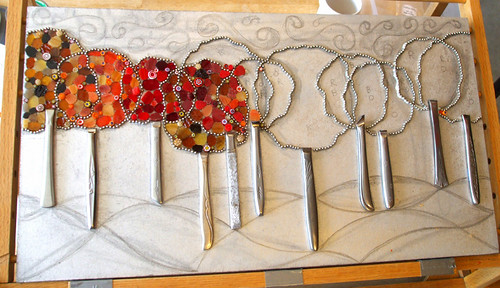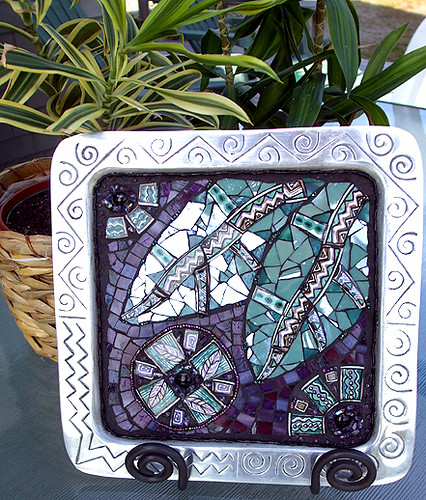Everything (and, everyone!) has a breaking point. As a mosaicist who cuts my own tiles and tesserae, I am constantly reminded of this. Sometimes I reach MY breaking point before I locate the best "breaking point" of the materials I am trying to cut.
 RHAPSODEEP IN BLUE from the Fish Hook Series - showing various tesserae made from dishware and mirror, some of which was broken and some which was hand cut.
RHAPSODEEP IN BLUE from the Fish Hook Series - showing various tesserae made from dishware and mirror, some of which was broken and some which was hand cut.
For tiles and tesserae, the "breaking point" can refer to either the pressure required to cut, nip or break the material OR to the exact point on the material (such as the edge of a plate or center of a tile) where, when the correct pressure is applied, the material breaks along the lines the cutter intends itto. With these types of materials, a silly little millimeter or fraction of a ppsi or even a flick of the wrist, can make all the difference.There are times when cuts just go well. You get the feel for the material, you find the right rhythm, you know exactly where the sweet spots are and how much pressure they need, and maybe you have newly sharpened wheels on your Leponitt (a cutting tool, somewhat similar to scissors, but which uses two opposing razor sharp wheels instead of blades), or perhaps you just get plain lucky and it all feels g-r-e-a-t. The ever useful Leponitt!
The ever useful Leponitt!
The more cutting I do, the better able I am to evaluate materials that come my way so that while it is always something of an experimentation with those first few cuts on newly acquired materials, I usually have some feel for what to expect from past experience with all the different substances I have used. However, the fact that I use old, recycled, salvaged and damaged materials for most of my work, provides an added dimension to the "breaking point" game.
Like the exploding plate I encountered last week. It didn't break, crack, chip or crumble when I applied my Leponitt. It EXPLODED. Yes, really exploded! The minute I put the Leponitt wheels to it, this lovely little black saucer I found at the dump exploded (with a sudden, soft sigh) into thousands of micro-sized shards that flew several feet into the air and then cascaded throughout the studio like sharp bits of ash. I've made plenty of bad cuts, but I have never actually exploded anything before — which leaves me wondering what that saucer was made of and what had happened in its life for it to have that kind of "breaking point"!

PURPLE PASSION FISH from the Fish Hook Series - showing tesserae of stained glass, tile and dishware that was all hand cut (not broken)
The problems inherent in trying to cut, nip, break or grind, old, weathered, chipped, cracked and broken materials into exact tesserae, identically proportioned tiles and accurate shapes, has, along with the fact that I recently celebrated a "milestone" birthday, gotten me to thinking. And thinking too much can be hazardous to someone brandishing a newly sharpened pair of Lepponittes...
I admit that the “used” nature of these recycled resources often makes them quite difficult to work with because no matter how carefully I make my cuts, the salvaged materials have a tendency to break along old stress points, crumble in weathered portions and shatter along invisible (to me, anyway) time-worn fracture lines that defy my best intentions. But, while this is sometimes frustrating (and it certainly makes the process more time consuming) it does make every cut, score, nip and snap an adventure into the unknown -- sometimes to the point that where I started out thinking I was going with a creation is not where I end up due to the unpredictable nature of "vintage" materials.

BAHAMA BLUSH from the Fish Hook Series - Tesserae hand cut from vintage china, dishware vitreous glass and drinking glasses.
As much as I might be loathe to admit it, there are certain parallels here to my own life as I notice my body, and those of family and friends, begin to weather and age. The key, I have decided, is to adapt and enjoy the places that I end up, even if they are not what I thought I had in mind when I started this journey. After all, I am a creation in the making and the challenge of knowing how to make the best of those critical "breaking points" and still enjoy the "sweet spots", is part of the art of living — and giving old materials new life is infinitely rewarding.

RUBY TWO FINS from the Fish Hook Series - tesserae hand cut from china, fiesta ware and vitreous glass tile.























